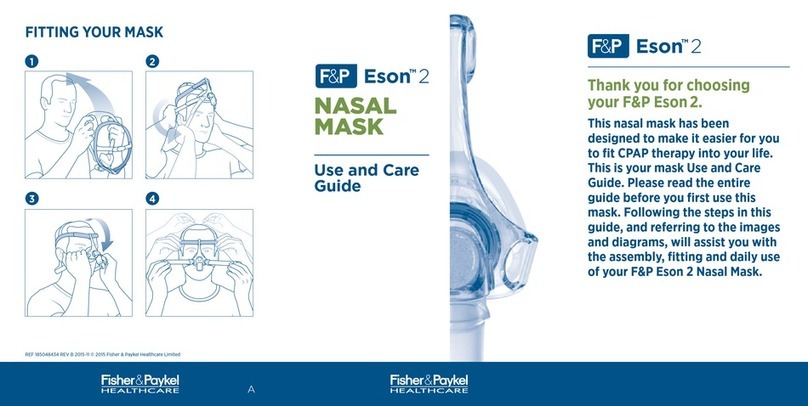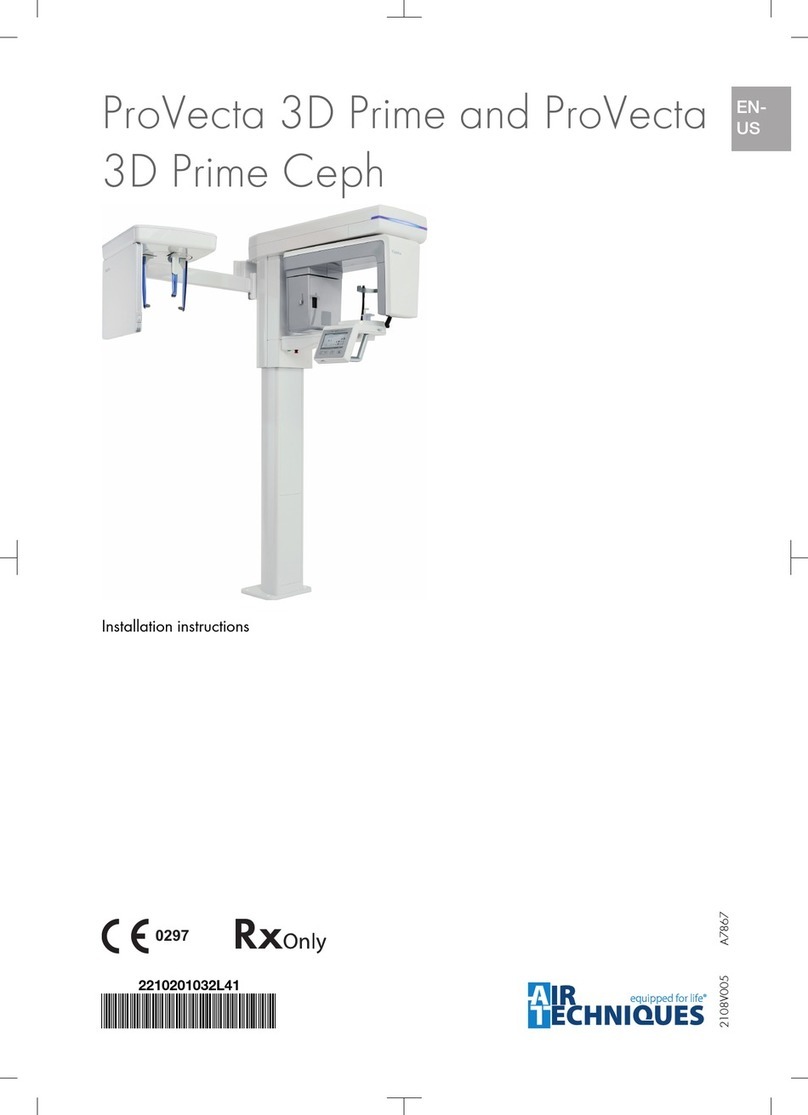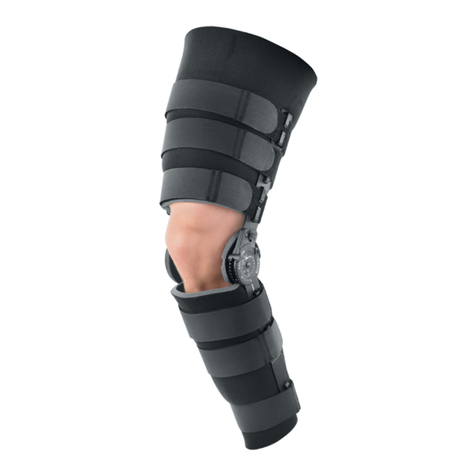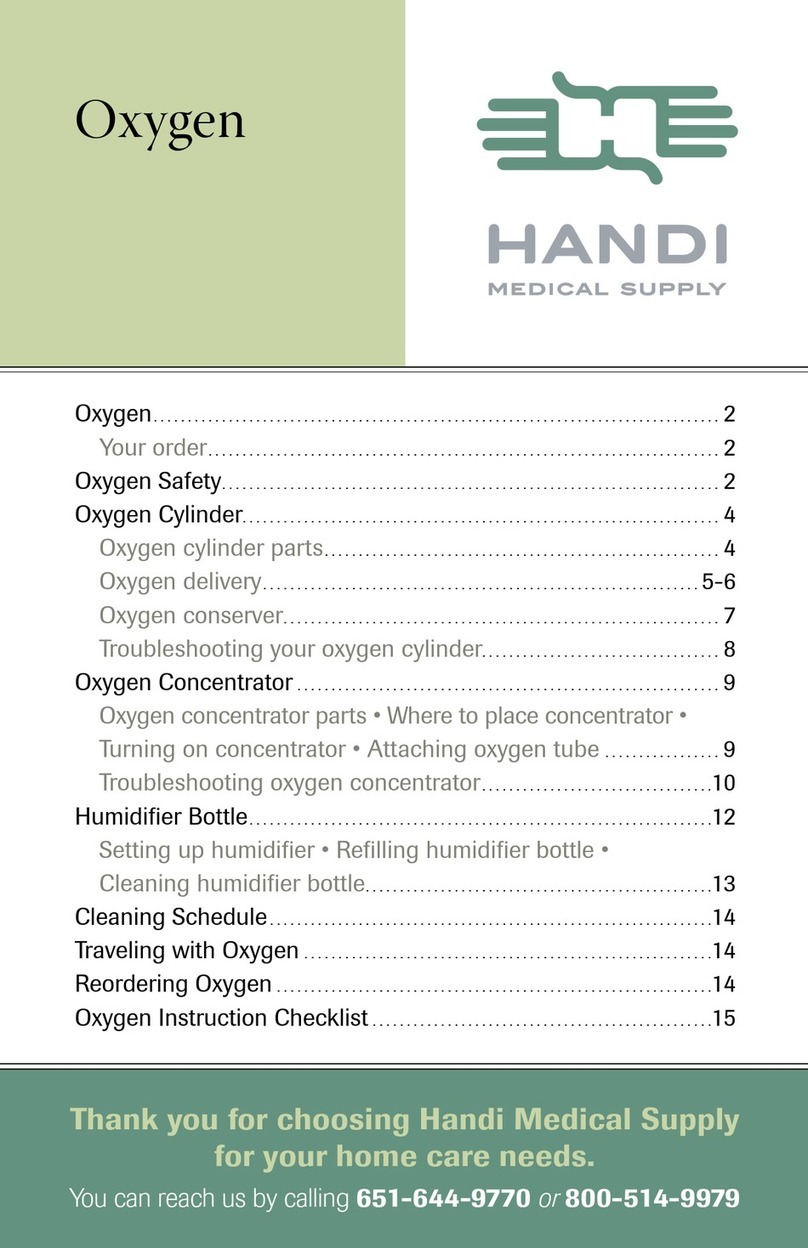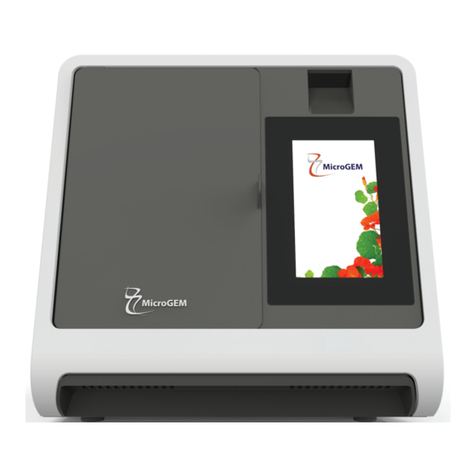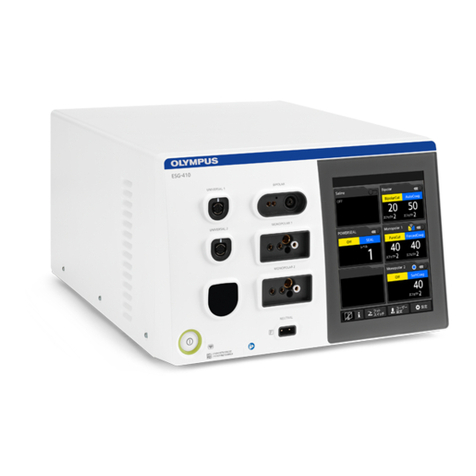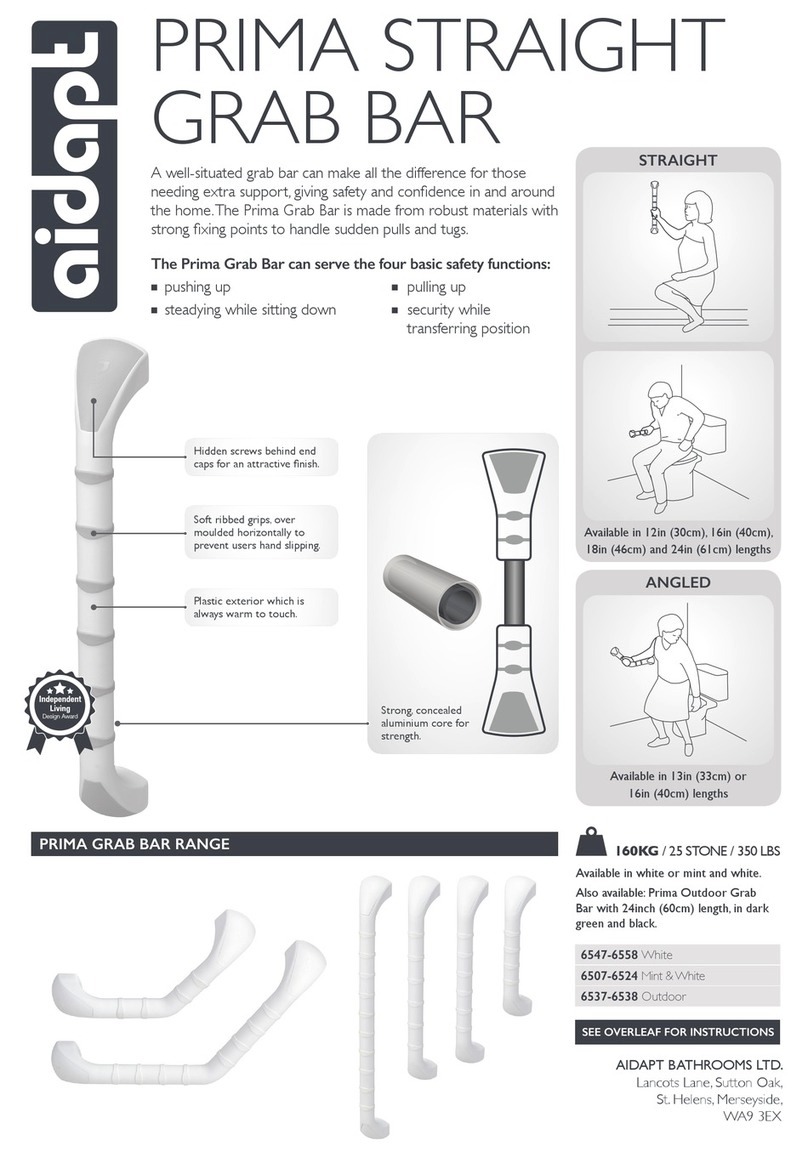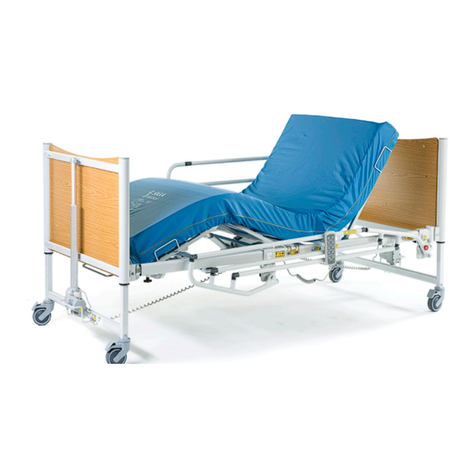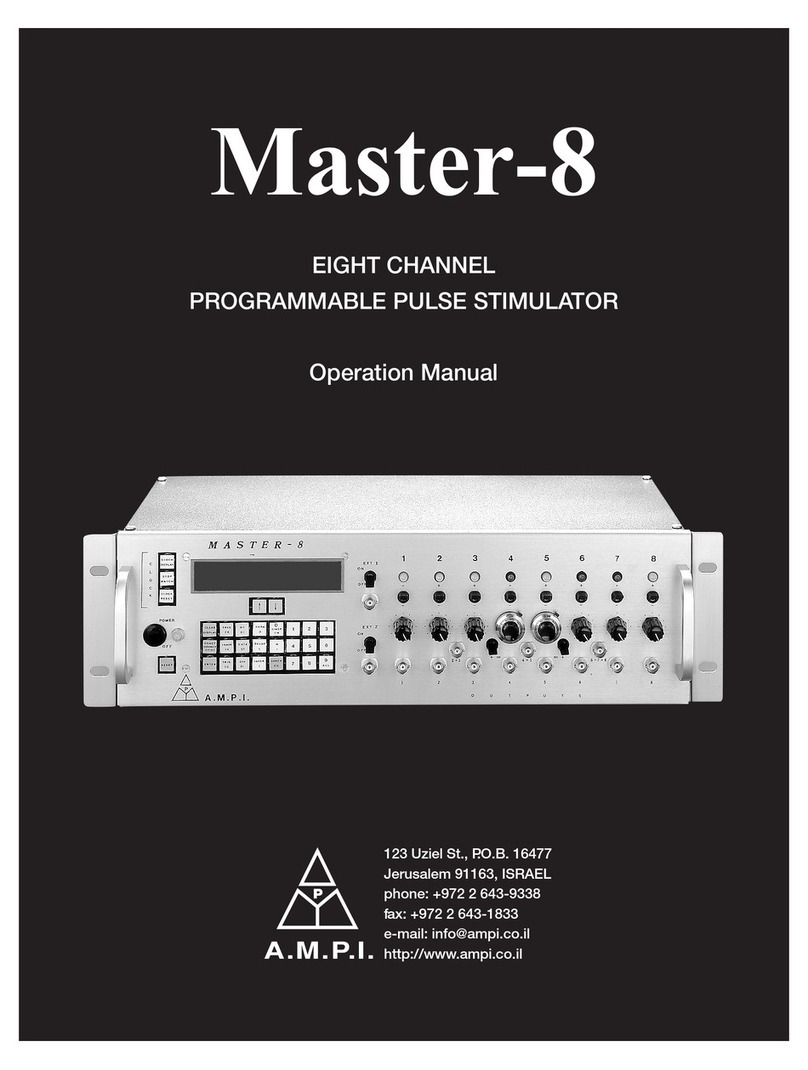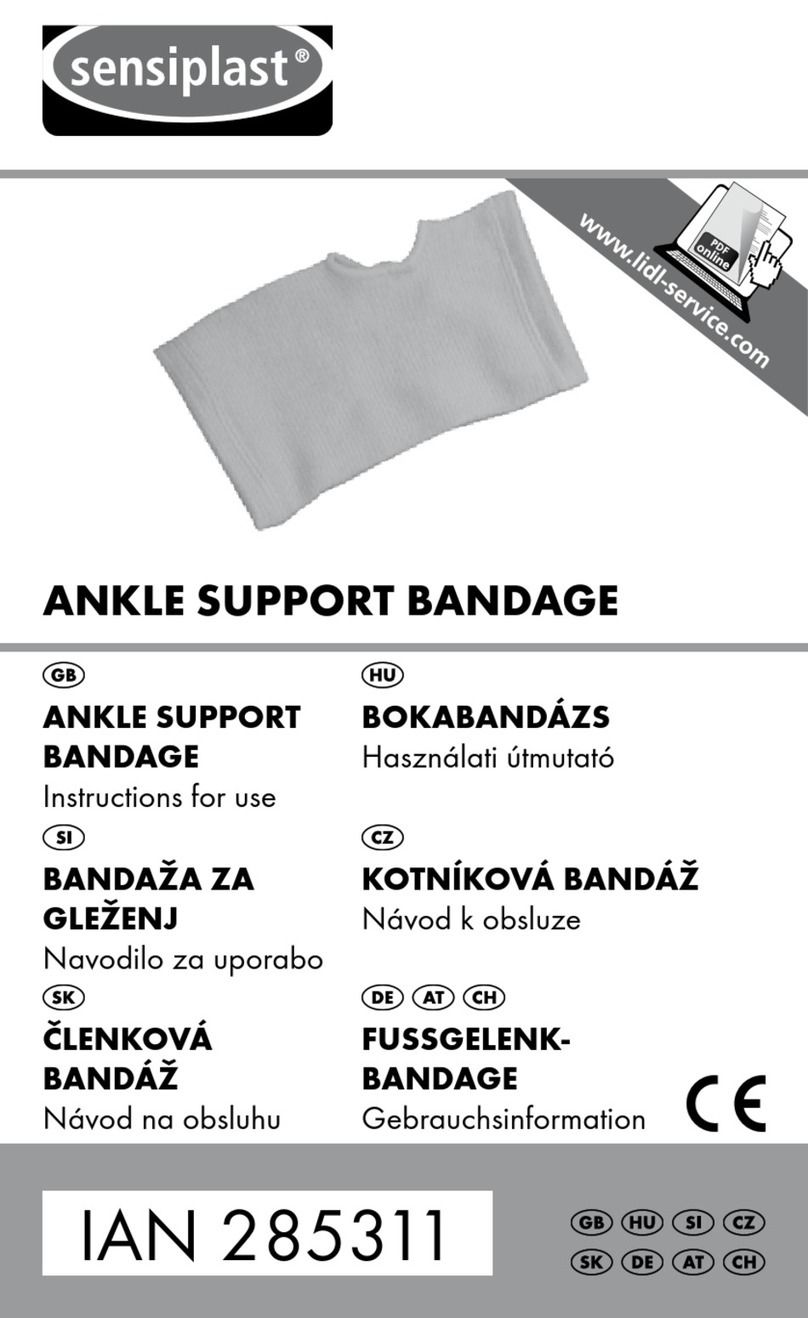Primedic DefiMonitor XD User manual

DefiMonitor XD
Operating instructions
English
24050 | GB | I
10/2021
www.primedic.com

Masthead
Publisher
Metrax GmbH
Rheinwaldstr. 22
D-78628 Rottweil
Germany
Phone: +49 741 257-0
Fax: +49 741 257-235
www.primedic.com
Revision: I
Date of issue: 10/2021
Proprietary note
Metrax GmbH reserves all rights to these instructions for use. These instructions for use may not be
duplicated or made accessible to third parties without the approval of Metrax GmbH. The same ap-
plies to individual parts and excerpts of these instructions for use.
Non-compliance with this gives rise to a right to claim damages and can have consequences under
criminal law.
We reserve the right to make amendments to these instructions for use.
Metrax GmbH
Rheinwaldstr. 22
78628 Rottweil
Germany

Table of contents
DefiMonitor XD | 24050 | GB | I
3 / 108
Table of contents
Masthead 2
1Glossary 7
2Introduction 7
2.1 Foreword 7
2.2 Validity 8
2.3 Disclaimers 8
2.4 Symbols used in these instructions for use 8
2.5 Pictograms 9
3Purpose 12
3.1 Functionality 12
3.2 Operational principle 12
3.3 Intended use 14
3.3.1 Medical indications 14
3.3.2 Medical contraindications 15
3.3.3 Intended patient group 15
3.3.4 Probable body part 16
3.3.5 Intended use environment 16
3.3.6 Intended user profile 16
4General safety advice 16
5Description of device 17
5.1 General description 17
5.2 Scope of delivery 18
5.3 Description of device details 19
5.3.1 Controls 22
5.3.2 Monitor display 23
5.3.3 Monitor symbols 24
6Preparatory measures before (initial) start-up 25
6.1 Power supply 26
6.1.1 Removing the energy module 27
6.1.2 Activate the AkuPak LITE XD 27
6.1.3 Inserting the energy module 28
6.1.4 Charging the AkuPak LITE XD 28
6.1.5 Battery capacity display on the monitor 29
6.1.6 Connection to the supply network 29
6.1.7 Separation from the supply network 30
7Using the DefiMonitor XD 30
7.1 Switching on / off 32
7.1.1 Switching on 32
7.1.2 Switching off 32
7.2 Device self-test 32
7.2.1 Self-test after switching on 33
7.2.2 Automatic, periodic self-tests 33

Table of contents
4 / 108
DefiMonitor XD | 24050 | GB | I
7.2.3 DefiMonitor XD status display 33
7.2.4 Internal error 35
7.3 Settings 35
7.3.1 Changing settings –time 35
7.3.2 Basic settings 36
7.4 Positioning the electrodes on the patient 37
7.4.1 Undressing the patient 38
7.4.2Removing chest hair 38
7.4.3 Drying the skin 38
7.4.4 SavePads 38
7.4.5 Paddles 39
7.4.6 Positioning the SavePads and/or paddles on adults 40
7.4.7 Positioning the SavePads and/or paddles on children 41
7.4.8 Opening and attaching SavePads 42
7.4.9 Positioning the ECG adhesive electrodes 43
7.5 Removing the electrodes from the patient 44
7.6 Fitting an SpO2 sensor 44
7.7 Removing an SpO2 sensor 45
7.8 Alarms and alarm limits 45
7.8.1 Alarms with high priority 45
7.8.2 Alarms with medium priority 46
7.8.3 Alarms with low priority 47
7.8.4 Informative messages 47
7.8.5 Messages in AED-Mode 53
7.8.6 Alarm volume 54
7.8.7 Alarm limits 54
7.8.8 Muting the alarm 55
7.9 ECG monitoring (ECG MON) 55
7.9.1Connecting the ECG electrodes 56
7.9.2 Changeover of ECG source 56
7.9.3 Switching the leads on the monitor 57
7.10 Manual asynchronous / synchronous defibrillation (MAN / SYNC) 57
7.10.1 Energy selection 58
7.10.2 Charging 58
7.10.3 Triggering defibrillation 59
7.11 SpO2 measurement 62
7.11.1 General SpO2 safety advice 63
7.11.2 Shown on the monitor 64
7.12 Pacer (PACE) 64
7.12.1 Setting the pacer modes 66
7.12.2 Setting stimulation frequencies 66
7.12.3 Setting stimulation intensities 66
7.12.4 Starting and stopping stimulation in pacer mode (PACE) 67
7.12.5 Defibrillation during pacing / Defibrillation via multifunction electrodes 68
7.13 AED-Mode (AED) 68
7.13.1 Voice messages 69
7.13.2 Carrying out ECG analysis in AED-Mode 69
7.13.3 Defibrillation required 70
7.13.4 Defibrillation not required 71
7.14 Keeping the defibrillator ready for use 71

Table of contents
DefiMonitor XD | 24050 | GB | I
5 / 108
7.14.1 MMI test (Man-Machine-Interaction) 72
7.15 Event button 72
7.16 Operating the printer 73
7.16.1 Inserting paper into the printer 73
7.16.2 Automatic self-test printout 73
7.16.3 ECG signal log 75
7.16.4 Automatic printout after each shock 76
7.16.5 Printing out the event memory 76
8SaveCard data management 76
8.1 Inserting / replacing the SaveCard 77
8.1.1 Inserting SaveCard 77
8.1.2 Changing SaveCard 78
9Cleaning, maintenance and shipping 78
9.1 Cleaning and disinfection 78
9.2 Servicing 79
9.3 Shipping 79
10 Disposal 79
11 Technical Data 80
11.1 Monitor 80
11.2 Alarms 80
11.3 Physical properties 80
11.4 Printer 80
11.5 Memory 81
11.6 Voltage supply 81
11.7 Environmental conditions 82
11.8 Sound definitions 83
11.9 Monitoring 83
11.9.1 ECG 83
11.9.2 SpO2 85
11.10 Treatment parameters 86
11.10.1 Biphasic curve properties 86
11.10.2 Manual defibrillation (asynchronous / synchronous) 88
11.10.3 Pacer 88
11.10.4 AED-Mode 89
11.11 Multifunction electrodes (SavePads) 89
12 Appendix 91
12.1 Illustration of time-current curves 91
12.2 General advice for using pulse oximeters 94
12.2.1 Data Update Period, Data Averaging, and Signal Processing 94
12.2.2 Functional versus Fractional Saturation 94
12.2.3 Performance Considerations 95
12.2.4 Nellcor™ Pulse Oximetry Sensors 97
12.2.5 Functional Testers and Patient Simulators 99
12.3 Rhythm detection system in AED-Mode 99
12.4 Electromagnetic compatibility 100
12.5 Optional accessories 104

Table of contents
6 / 108
DefiMonitor XD | 24050 | GB | I

Glossary
DefiMonitor XD | 24050 | GB | I
7 / 108
1 Glossary
Term / abbreviation
Description
AED
Automated external defibrillator
AHA
American Heart Association
AkuPak LITE XD
Rechargeable energy module
bpm
“beats per minute”
EAR
Used Electronic Appliances Register
ECG
Electrocardiogram
ElektroG
German Electrical and Electronic Equipment Act
ERC Guidelines
European Resuscitation Council guidelines on cardiopulmonary re-
suscitation (CPR)
HF
High frequency
CPR
Cardiopulmonary resuscitation
Internal buffer battery
Internal buffer battery for continued running of DefiMonitor XD real-
time clock if no energy module is inserted.
MDD
Medical Device Directive
MIT
Massachusetts Institute of Technology
ms
millisecond
ÖRE
Public law
Patient impedance
Patience resistance between the SavePads
SaveCard
Memory card for data transfer
s
second
SavePads
Self-adhesive multifunction electrodes for defibrillation, stimulation,
monitoring, cardioversion
WEEE
Waste of Electrical and Electronic Equipment
2 Introduction
2.1 Foreword
Dear User,
You are faced with the task of using the DefiMonitor XD on human beings in a medical emergency!
To ensure that you can react quickly and correctly in this special situation and can optimally use the
options given with the device, it is necessary for you to read through these operating instructions in
your own time beforehand to familiarise yourself with the device, its functions and the areas of applica-
tion.
Keep these instructions for use near the device so that you consult them for any queries which may
arise.
If you have any questions regarding the start-up, use or maintenance of the DefiMonitor XD please do
not hesitate to contact us.
In case of unexpected device behaviour or events, please contact us.
The instructions given on the device are no substitute for reading these operating instructions.
Serious incidents related to the defibrillator must be reported. If the defibrillator has not performed as
expected, contact the manufacturer and the appropriate local authority.

Introduction
8 / 108
DefiMonitor XD | 24050 | GB | I
A "serious incident" means an event that has had, could have had, or may have had, directly or indi-
rectly, any of the following consequences
•the death of a patient, user or other person
•the temporary or permanent serious deterioration of the health status of a patient, user or other
person
•a serious risk to public health.
You will find our contact address on the masthead at the start of these instructions for use.
2.2 Validity
The descriptions in these operating instructions refer to all models in the DefiMonitor XD range of de-
fibrillators made by Metrax GmbH.
These operating instructions describe the software version ARM 1.XX, DSP 4.XX.
Please note that, depending on the model, your DefiMonitor XD may not have all the features de-
scribed in these operating instructions. Refer to the start dialogue of your DefiMonitor XD to determine
which model you have.
The DefiMonitor XD is run using an AkuPak LITE XD. This item will also be referred to as an energy
module in this document.
SavePads are self-adhesive multifunction electrodes which can be used for defibrillation, stimulation,
monitoring and cardioversion. For statements in these operating instructions concerning all SavePads
models, they will be referred to simply as SavePads. If there are specifics for using individual models,
the item description will be given in full (e.g. SavePads Connect).
The content of this document can be changed without prior notice.
2.3 Disclaimers
Liability claims for personal injury and damage to property are excluded if they are attributable to one
or more of the following causes:
■Using the device in a manner for which it was not intended.
■Improper use and maintenance of the device.
■Operating the device with the protective covers removed or if there is obvious damage to the ca-
bles and/or electrodes.
■Non-observance of the advice given in these instructions for use with regard to operation, mainte-
nance and repair of the device.
■Customer intervention, repairs or constructional changes to the device.
■Autonomous exceeding of the performance limits.
■Lack of monitoring of parts that are subject to wear and tear.
■Treating patients without prior indication.
2.4 Symbols used in these instructions for use
Note
This symbol indicates text which contains important information.
Follow the instructions in the order in which they are given in the instructions for use. The instructions
are structured as follows:
Procedure:
•First instruction
•Second instruction

Introduction
DefiMonitor XD | 24050 | GB | I
9 / 108
➢Possible interim result
•etc.
✓Possible final result
■This symbol indicates a list.
Numbers in brackets, e.g. (3), refer to items in figures.
Voice messages or voice instructions are in bold in these instructions for use. In some instances, they
will be shown as text messages on the monitor at the same time.
Settings options will be placed in “ “.
2.5 Pictograms
Symbol
Meaning
Serial number
CE symbol for the notified body
CE symbol
HIBC / UDI code (example)
GOST R symbol
EAC symbol
Medical device
Applied part, defibrillation-proof, type CF
Protection class II
Do not dispose of device in household waste
IP33
Protected against solid foreign objects larger than 2.5 mm and against
spraying water
Manufacturer and production date if necessary YYYY-MM-DD
Follow the instructions for use
"General warning” safety symbol – the individual meanings are explained
in the operating instructions
Dangerous electrical voltage (high voltage)

Introduction
10 / 108
DefiMonitor XD | 24050 | GB | I
Symbol
Meaning
Caution
Service life of the internal battery YYYY-MM-DD
Do not short-circuit energy module
Do not open or disassemble energy module
Protect energy module from fire
For adults and children more than 8 years old and with a bodyweight
greater than 25 kg
For children aged 1 –8 and with a bodyweight up to a maximum of 25 kg
Infants up to the age of 1
SavePads Connect can only be used in conjunction with a coded Save-
Pads Connect cable
Contains no hazardous substances and can be recycled
Open packaging here
Do not use if packaging is damaged
Do not bend or fold the electrodes and do not store beneath heavy items
Recycling code for low-density polyethylene
Do not reuse
non sterile
Can be used a maximum of 24 hours after opening
Observe the instructions for use
Not made from natural latex

Introduction
DefiMonitor XD | 24050 | GB | I
11 / 108
Symbol
Meaning
Batch code
Article number
Global Trade Item Number
Can be used until YYYY-MM-DD
Maximum frequency of use for 1 pair of multifunction electrodes (Save-
Pads) for defibrillation
Maximum duration of use for 1 pair of multifunction electrodes (SavePads)
for monitoring
Maximum duration of use for ECG electrodes
Maximum duration of use for 1 pair of multifunction electrodes (SavePads)
for pacing
Positioning and handling the SavePads
1. Dry skin
2. Open the packaging of the electrodes
3. Pull off protective foil
4. Attach SavePads and smooth out
Positioning and handling the SavePads Mini
1. Dry skin
2. Open the packaging of the electrodes
3. Pull off protective foil
4. Attach SavePads and smooth out
Prescription only
Silver / Silver Chloride
Remove chest hair
Dry skin
Connect the ECG cable to the ECG electrodes

Purpose
12 / 108
DefiMonitor XD | 24050 | GB | I
Symbol
Meaning
Remove protections foil
Attach the ECG electrode to the skin and press down with circular move-
ments
Store remaining ECG electrodes in their original packaging. Close the
packaging by folding the opening twice
This side up
Fragile goods
Protect from heat (solar radiation)
Protect from moisture
Air pressure in hPa
Humidity specification in %
Permissible temperature range in Celsius and Fahrenheit
3 Purpose
3.1 Functionality
The DefiMonitor XD is a portable defibrillator / monitor that is intended for use of trained medical per-
sonnel in indoor and out-of-doors emergency care setting with environmental condition specified in the
technical data. DefiMonitor XD is designed to be used during ground transportation. DefiMonitor XD is
battery powered and can be powered by mains. The battery has to be inserted for operation. DefiMon-
itor XD may only be used on one patient at a time.
For additional intended use information see below.
Function
Availability
ECG monitoring
Standard
Async manual defibrillation
Standard
Sync manual defibrillation
Standard
AED-Mode
Option
Pacing
Option
Pulse oximetry (SpO2)
Option
3.2 Operational principle
ECG
The electrocardiogram (ECG) records the electrical activity of the heart. The ECG allows the interpre-
tation and identification of cardiac rhythm, dysrhythmias and calculation of heartrate. The ECG is

Purpose
DefiMonitor XD | 24050 | GB | I
13 / 108
captured by multifunction electrodes or ECG electrodes on the patient's skin what allows the electrical
activity to be monitored and recorded. ECG monitoring is used in addition to assess the patient, do not
rely solely on the ECG monitor, care should be taken to assess the patient at all time.
Asynchronous Defibrillation
DefiMonitor XD applies a high-intensity current pulse to the patient to treat life-threatening cardiac ar-
rhythmia.
The high-intensity current pulse is called defibrillation. DefiMonitor XD will apply high-intensity current
pulse in biphasic waveform. In adult mode, DefiMonitor XD will apply up to 360J, in pediatric mode up
to 100J.
DefiMonitor XD DefiMonitor XD provides asynchronous manual defibrillation using multifunction elec-
trodes or paddles.
Synchronous Defibrillation (Cardioversion)
DefiMonitor XD applies a high-intensity current pulse synchronized to R-wave of the ECG to the pa-
tient to treat cardiac arrhythmia.
The high-intensity current pulse is called defibrillation. DefiMonitor XD will apply high-intensity current
pulse in biphasic waveform. In adult mode, DefiMonitor XD will apply up to 360J, in pediatric mode up
to 100J.
DefiMonitor XD DefiMonitor XD provides synchronous manual defibrillation using multifunction elec-
trodes or paddles.
Pacemaker therapy
Pacemaker therapy mode generates electrical impulses delivered by multifunction electrodes on the
patient’s chest to contract the heart muscle and regulate the electrical conduction system of the heart.
By this the heart rate of the patient can be controlled by the pacemaker therapy.
The electrical stimulus is applied from one electrode to the other electrode.
AED-Mode
AED-Mode is intended for treating patients with symptoms of sudden cardiac arrest. AED-Mode pro-
vides treatment protocol using voice and visual guidance to operator. After the multifunction electrodes
are attached the patient’s chest or upper back DefiMonitor XD analyses the patient’s heartbeat. Defi-
Monitor XD will deliver a high-intensity current pulse to the patient. The high-intensity current pulse is
delivered by the multifunction electrodes. The high-intensity current pulse is delivered when the opera-
tor presses the shock button
The high-intensity current pulse is called defibrillation. DefiMonitor XD will apply high-intensity current
pulse in biphasic waveform. In adult mode, DefiMonitor XD will apply up to 360J, in pediatric mode up
to 100J.
SpO2
SpO2 Monitoring uses pulse oximetry to measure functional oxygen saturation in the blood. Pulse oxi-
metry works by applying a Nellcor™ sensor to tissue regions with rich presence of capillaries and arte-
rioles, such as a finger or toe. The sensor contains a dual light source and a photodetector.
Bone, tissue, pigmentation, and venous vessels normally absorb a constant amount of light over time.
The vascular bed normally pulsates and absorbs variable amounts of light during the pulsations. The
ratio of light absorbed is translated into a measurement of functional oxygen saturation (SpO2).
Ambient conditions, sensor application, and patient conditions can influence the ability of the monitor-
ing cable to accurately measure SpO2.
Pulse oximetry is based on two physical principles: oxyhemoglobin and deoxyhemoglobin differ in their
absorption of red and infrared light (measured using spectrophotometry), and the volume of arterial
blood in tissue (and hence, light absorption by that blood) changes during the pulse (registered using
plethysmography). A monitoring system determines SpO2 by passing red and infra-red light into a vas-
cular bed and measuring changes in light absorption during the pulsatile cycle. Red and infrared low-
voltage light-emitting diodes (LED) in the sensor serve as light sources; a photo diode serves as the
photo detector.
Since oxyhemoglobin and deoxyhemoglobin differ in light absorption, the amount of red and infra-red
light absorbed by blood is related to hemoglobin oxygen saturation.

Purpose
14 / 108
DefiMonitor XD | 24050 | GB | I
The monitoring cable uses the pulsatile nature of arterial flow to identify the oxygen saturation of arte-
rial hemoglobin. During systole, a new pulse of arterial blood enters the vascular bed, and blood vol-
ume and light absorption increase. During diastole, blood volume and light absorption reach their low-
est point. The monitoring cable bases its SpO2 measurements on the difference be-tween maximum
and minimum absorption (measurements at systole and diastole). By doing so, it focuses on light ab-
sorption by pulsatile arterial blood, eliminating the effects of non-pulsatile absorbers such as tissue,
bone, and venous blood.
3.3 Intended use
ECG
Monitor the electrical activity of the heart.
Asynchronous Defibrillation
Treatment of life-threatening cardiac arrhythmia applying high-intensity current pulse to patient’s
chest or upper back.
Synchronous Defibrillation (Cardioversion)
Treatment of cardiac arrhythmia applying high-intensity current pulse to patient’s chest or upper back.
Pacemaker therapy
Treatment of cardiac arrhythmia applying an electrical stimulus to patient’s chest or upper back.
AED-Mode
Treatment of life-threatening cardiac arrhythmia applying high-intensity current pulse to patient’s
chest or upper back.
SpO2
SpO2 monitoring included in DefiMonitor XD is a portable pulse oximeter intended as a continuous
non-invasive monitor of arterial oxygen saturation (SpO2) and pulse rate of adult, pediatric, and neo-
natal patients during both no motion and motion conditions, and for patients who are well or poorly
perfused. The monitoring system is intended for use in hospitals, hospital-type facilities, and during
intra-hospital transport.
3.3.1 Medical indications
ECG
ECG monitoring is indicated for recognition of the heart rhythm and to monitor the heart rate of the pa-
tient.
Asynchronous defibrillation
Manual asynchronous defibrillation is indicated for the termination of certain potentially fatal arrhyth-
mias, such as ventricular fibrillation and ventricular tachycardia.
Synchronous defibrillation (cardioversion)
Manual synchronous defibrillation (Cardioversion) is indicated for the treatment of atrial fibrillation,
atrial flutter paroxysmal supraventricular tachycardia and in relatively stable ventricular fibrillation.
Pacemaker therapy
DEMAND / FIX: Pacemaker therapy in DEMAND or FIX pacer mode is intended for treatment of symp-
tomatic bradycardia with pulse.
OVERDRIVE: Pacemaker therapy in OVERDRIVE pacer mode is intended for suppression of tachy-
cardia.

Purpose
DefiMonitor XD | 24050 | GB | I
15 / 108
AED-Mode
AED-Mode should be used when the patient has all of the following symptoms:
■Unconsciousness
■Absence of normal breathing
■Absence of signs of circulation
SpO2
Nellcor OxiMax™ technology allows the use of different types of SpO2 sensors. The indications of the
sensors are listed in the instructions for use of the sensors.
3.3.2 Medical contraindications
ECG
No contraindications known.
Asynchronous defibrillation
Manual asynchronous defibrillation is contraindicated in the treatment of Pulseless Electrical Activity
(PEA) and in the treatment if asystole. Defibrillation is unintended for patient who show signs of circu-
lation.
Synchronous defibrillation (cardioversion)
Synchronous defibrillation (Cardioversion) is contraindicated in the treatment of Pulseless Electrical
Activity (PEA), such as idioventricular or ventricular escape rhythms, and in the treatment of asystole.
AED-Mode
AED-Mode should not be used if the patient shows one of following symptoms:
■Consciousness
■Breathing
■Signs of circulation
Pacemaker therapy
DEMAND / FIX: Pacemaker therapy in DEMAND or FIX pacer mode is unintended for treatment of
ventricular fibrillation or asystole.
OVERDRIVE: Pacemaker therapy in OVERDRIVE pacer mode is unintended for treatment of ventricu-
lar fibrillation or asystole.
SpO2
Nellcor OxiMax™ technology allows the use of different types of SpO2 sensors. The contraindications
are listed in the instructions for use of the sensors.
3.3.3 Intended patient group
ECG
Patients older than one year where heart rate and heart rhythm recognition is indicated.
Asynchronous defibrillation / synchronous defibrillation (Cardioversion)
Patients where asynchronous or synchronous defibrillation is indicated.
Patients older than one year but with less body weight than 25kg shall be treated with SavePads Mini
in pediatric mode or child paddles and a maximum energy of 100J.
Pacemaker therapy
Patients older than one year where pacemaker therapy is indicated.
SpO2
Nellcor OxiMax™ technology allows the use of different types of SpO2 sensors. The intended patient
group is specified in the instruction for use if the SpO2 sensor.

General safety advice
16 / 108
DefiMonitor XD | 24050 | GB | I
AED-Mode
Patients older than one year that show symptoms of sudden cardiac arrest.
Patients older than one year but with less body weight than 25kg shall be treated with SavePads Mini
in pediatric mode.
3.3.4 Probable body part
ECG electrodes
ECG electrodes are attached to the patient’s chest.
Multifunction electrodes
SavePads Connect, SavePads Mini Connect, SavePads, SavePads PreConnect, SavePads Mini are
attached to the patient’s chest or upper back.
Paddles
Adult / Pediatric paddles are attached to the patient’s chest.
SpO2
Nellcor OxiMax™ technology allows the use of different types of SpO2 sensors. The applied part de-
pends on the sensor used. The applied part is defined in the instructions for use of the sensor itself.
3.3.5 Intended use environment
The DefiMonitor XD will be used on scene of emergency. The DefiMonitor XD can be used in road am-
bulances as well. The limitations for temperature, humidity and air pressure are specified in chapter
11.7.
3.3.6 Intended user profile
The DefiMonitor XD is intended to be used by trained medical personnel who are familiar with basic
monitoring, vital sign assessment, resuscitation situations and trained on the use of DefiMonitor XD.
While using the DefiMonitor XD, the patient has to be attended by trained medical personnel con-
stantly.
4 General safety advice
Read the operating instructions carefully before using the DefiMonitor XD for the first time. Only use
the DefiMonitor XD as described in the instructions for use.
Consider the environmental conditions mentioned in the technical specifications when storing and op-
erating the device.
Install the DefiMonitor XD so that you can separate the device from the supply network at any time.
Follow the instructions of the DefiMonitor XD.
Use the DefiMonitor XD on a non-conductive base only. Do not use the DefiMonitor XD in standing
water or in the rain.
Do not use the DefiMonitor XD in the presence of flammable materials.
The DefiMonitor XD and its accessories are safe when used as intended and when following the de-
scriptions and information detailed in these operating instructions. Despite this, if used incorrectly, the
DefiMonitor XD and its accessories can be dangerous to the user, the patient or third parties!
Do not touch the contacts on the DefiMonitor XD or on the energy module.
The use of several medical devices simultaneously may present a danger to the patient as a result of
the cumulation of patient currents.
Keep the device away from children!
Only the use of original accessories specified in these instructions for use provides defibrillation pro-
tection.
The warnings in the following chapters indicate dangers and must be heeded to avoid the dangers.
They are divided into various escalation levels, see the following warnings.

Description of device
DefiMonitor XD | 24050 | GB | I
17 / 108
DANGER
Texts marked DANGER indicate an extraordinarily serious immediate danger which will defi-
nitely lead to serious injury or even death if no preventative measures are adopted! It is im-
perative that you pay attention to these texts!
WARNING
Texts marked WARNING indicate an extraordinarily serious potential danger which could
lead to serious injury or even death if no preventative measures are adopted! It is imperative
that you pay attention to these texts!
CAUTION
Texts marked CAUTION indicate a potentially dangerous situation which could lead to minor
injuries! It is imperative that you pay attention to these texts!
5 Description of device
5.1 General description
The DefiMonitor XD is an external defibrillator with integrated 6-channel ECG. The ECG can be rec-
orded either via the SavePads, the defibrillation paddles or the four-pin patient cable with self-adhe-
sive ECG electrodes. The DefiMonitor XD is available in various models. The respective model will be
shown on the monitor when the defibrillator is turned on.
The DefiMonitor XD is available in the following models:
Model
Product designations so far
Basic
device
AED
option
PACER
option
SPO2
option
DefiMonitor XD
DefiMonitor XD1 / DefiMoni-
tor XD1xe
X
DefiMonitor XD SPO2
DefiMonitor XD3 / DefiMoni-
tor XD3xe
X
X
DefiMonitor XD PACER
DefiMonitor XD10 / Defi-
Monitor XD10xe
X
X
DefiMonitor XD PACER,
SPO2
DefiMonitor XD30 / Defi-
Monitor XD30xe
X
X
X
DefiMonitor XD AED
DefiMonitor XD100 / Defi-
Monitor XD100xe
X
X
DefiMonitor XD AED,
PACER
DefiMonitor XD110 / Defi-
Monitor XD110xe
X
X
X
DefiMonitor XD AED, SPO2
DefiMonitor XD300 / Defi-
Monitor XD300xe
X
X
X
DefiMonitor XD AED,
PACER, SPO2
DefiMonitor XD330 / Defi-
Monitor XD330xe
X
X
X
X
For all models, energy is provided by the AkuPak LITE XD or via the mains. For further information re-
garding the AkuPak LITE XD, please refer to the separate operating instructions.
A wide range of accessories are available. The handling of the accessories is described in separate
operating instructions in-part.
The lifetime of DefiMonitor XD is 10 years.

Description of device
18 / 108
DefiMonitor XD | 24050 | GB | I
5.2 Scope of delivery
After delivery, first of all check the packaging and the device for transport damage.
If you notice any damage to the device, immediately contact your transport company or dealer, or di-
rectly contact the technical service at Metrax GmbH, stating the device number and describing the
damage to the device.
Satisfy yourself that the scope of delivery is complete in accordance with the enclosed delivery note
(standard accessories).
Article
Article no.
Further information
DefiMonitor XD
model dependent
language de-
pendent
AkuPak LITE XD
97311
Power supply cord M290 SK II EU black 2,5 m
or
Power supply cord M290 SK II USA black 2,5 m
23955
24026
only for Latin America
SavePads Connect cable coded
97384
Cable length 3.6 m
SavePads Connect (1 pair)
96516
Paddle set XD
96591
ECG patient cable 4-pole coded IEC
97386
Cable length 3.6 m
ECG electrodes, 1 pack = 30 pcs.
-
Printer paper, 1 roll
-
Contact gel, 1 tube
-
SaveCard
20770
Instructions for useDefiMonitor XD
language de-
pendent
Instructions for use AkuPak LITE XD
language de-
pendent
only for devices with SPO2 option:
Nellcor SpO2 finger sensor FLEXMAX
97802
reusable, patient
weight >20 kg
Nellcor SPO2 interface cable DOC10
97221
Cable length 3 m
Subject to change without notice.

Description of device
DefiMonitor XD | 24050 | GB | I
19 / 108
5.3 Description of device details
Fig. 1 DefiMonitor XD –front view
1
Carry handle
2
Paddle
3
Paddle cable, detachable
4
Membrane keypad (option-dependent, here: DefiMonitor XD AED, PACER, SPO2)
5
Monitor
6
Status display
Fig. 2 DefiMonitor XD –rear view (similar to illustration)
1
Opening for single-hand release hook
2
Identification plate
3
Quality seal

Description of device
20 / 108
DefiMonitor XD | 24050 | GB | I
Fig. 3 DefiMonitor XD –bottom view
1
SaveCard cover
2
Release button (to remove the energy module)
3
Energy module AkuPak LITE XD
Fig. 4 DefiMonitor XD –left-hand side view
1
Slot for paddle
2
Loudspeaker
3
Socket for electrode connector
4
Socket for paddle connector
5
Socket for SpO2 sensor (optional)
6
Attachment point for bag
Other manuals for DefiMonitor XD
1
Table of contents
Other Primedic Medical Equipment manuals

Primedic
Primedic HeartSave User manual
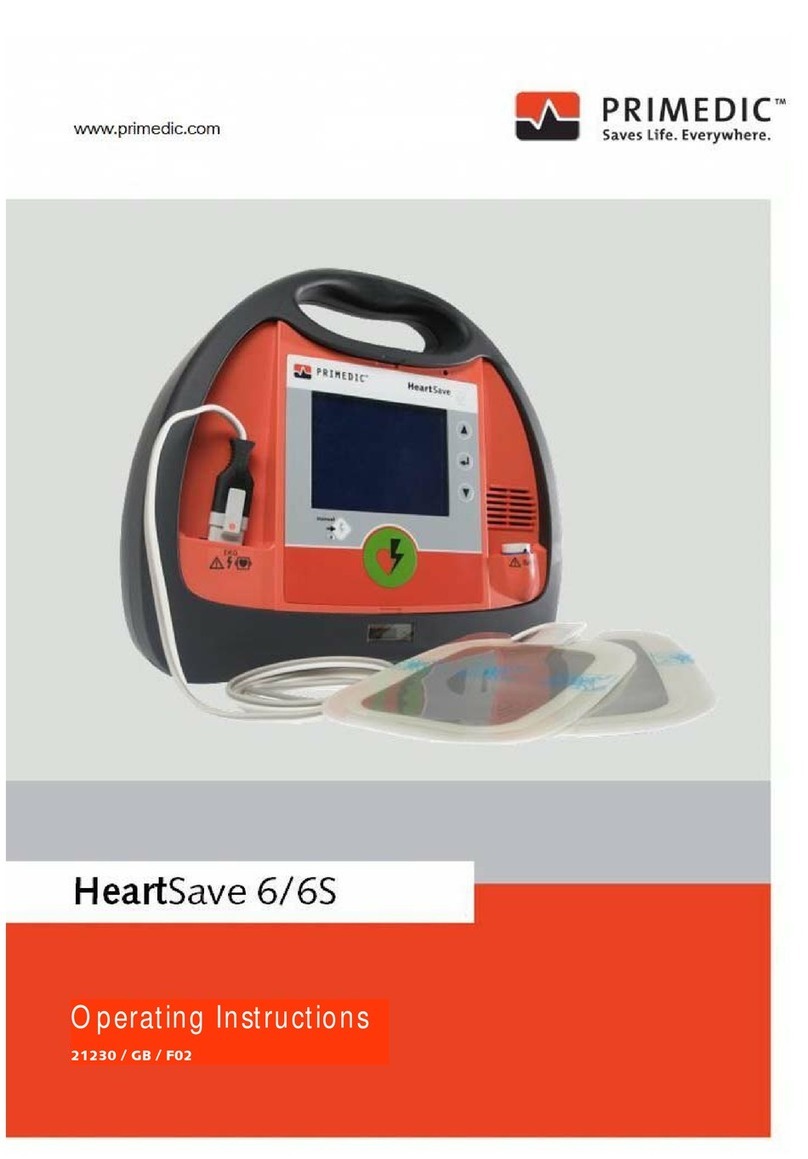
Primedic
Primedic HeartSave 6 User manual
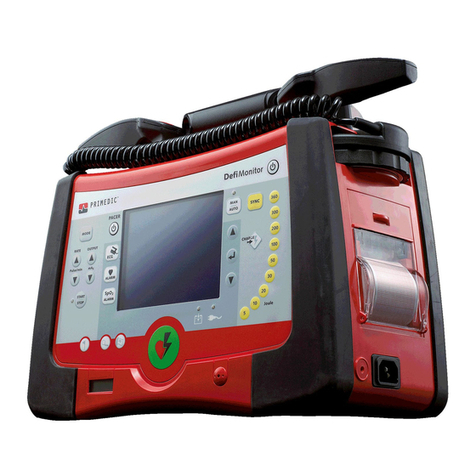
Primedic
Primedic DefiMonitor XD Series User manual
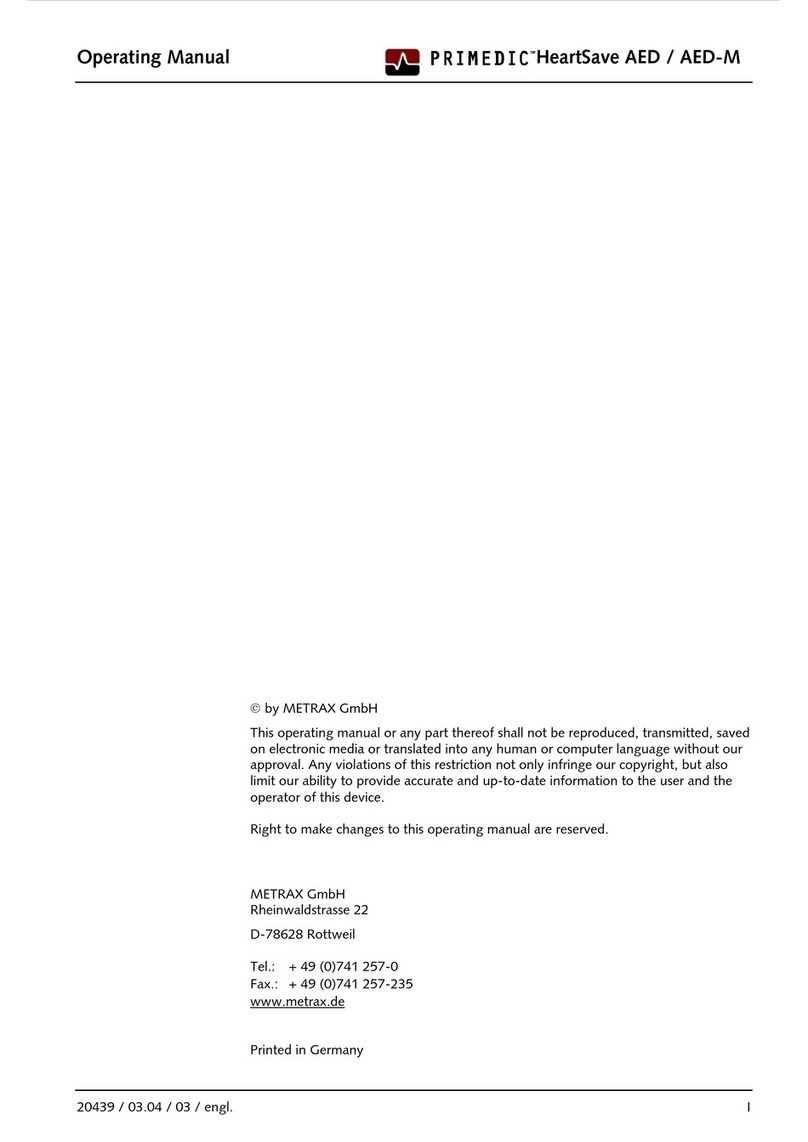
Primedic
Primedic HeartSave AED User manual
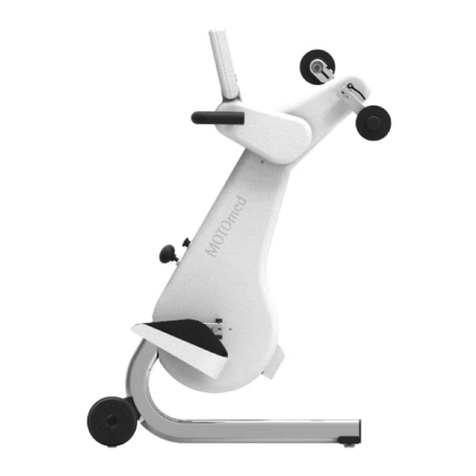
Primedic
Primedic RECK MOTOmed loop User manual
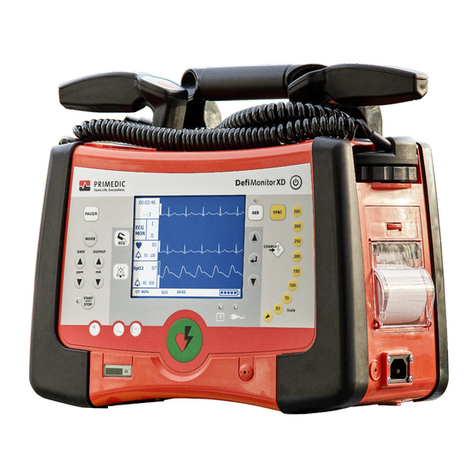
Primedic
Primedic DefiMonitor XD User manual
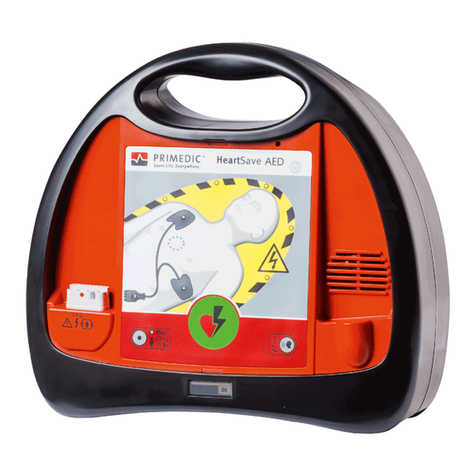
Primedic
Primedic HeartSave AED User manual
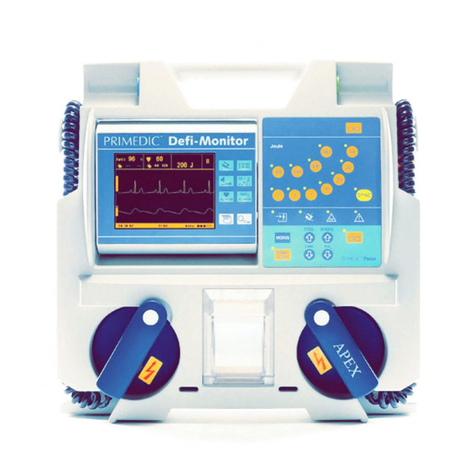
Primedic
Primedic Defi-Monitor ECO 1 User manual
Popular Medical Equipment manuals by other brands
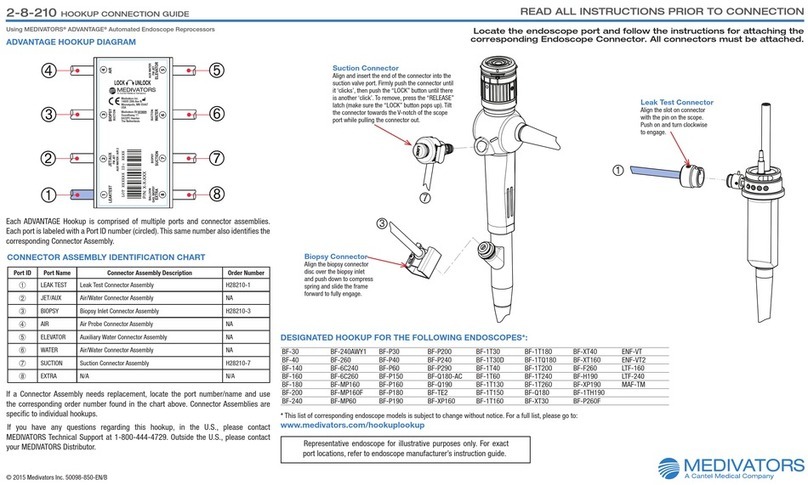
Cantel Medical
Cantel Medical Medivators BF-30 instructions
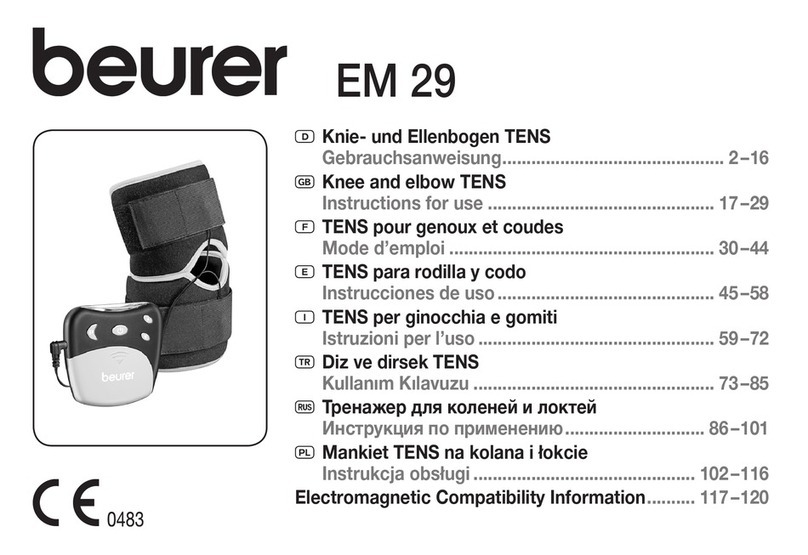
Beuer
Beuer EM 29 Instructions for use
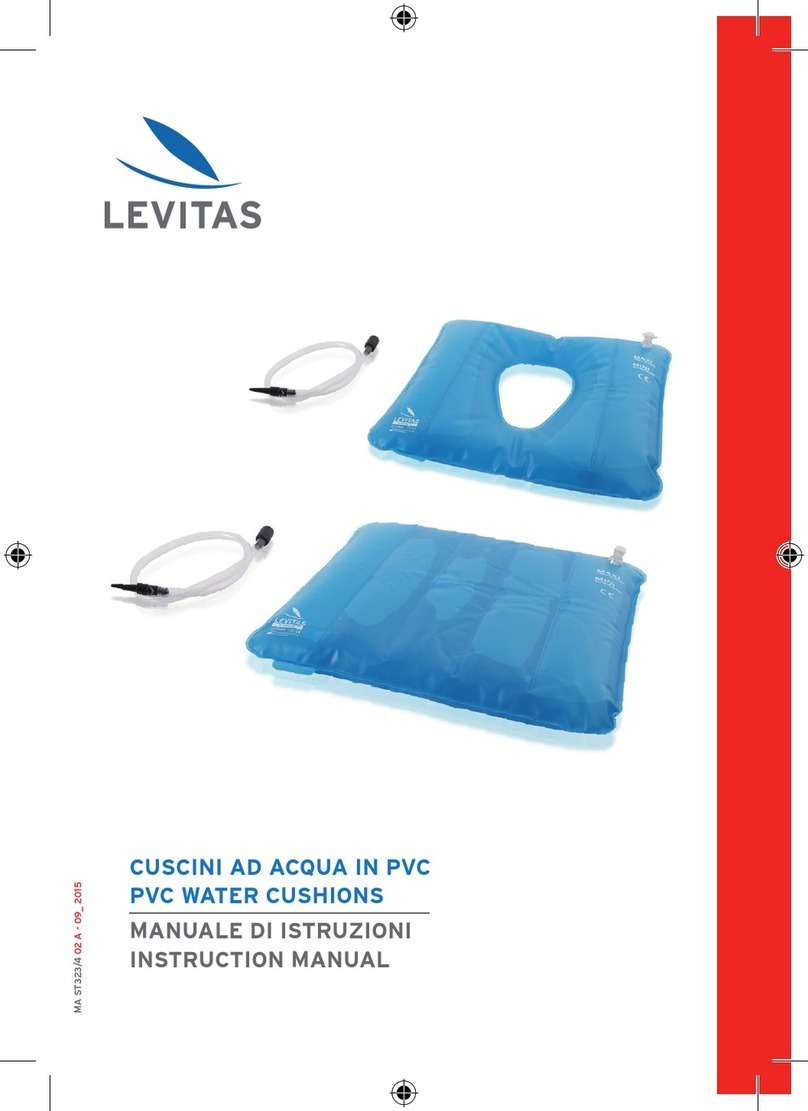
LEVITAS
LEVITAS ST323 instruction manual

Lepu Medical
Lepu Medical Lepgen-96 operation instruction
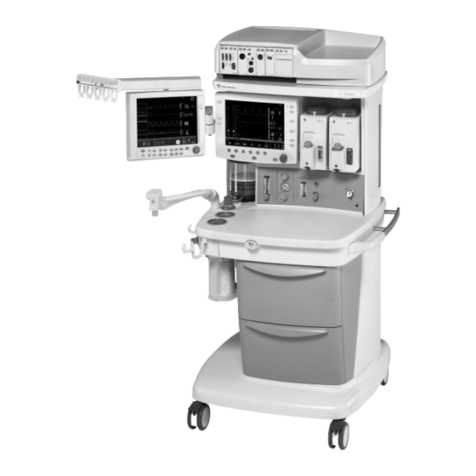
Datex-Ohmeda
Datex-Ohmeda Avance User's reference manual
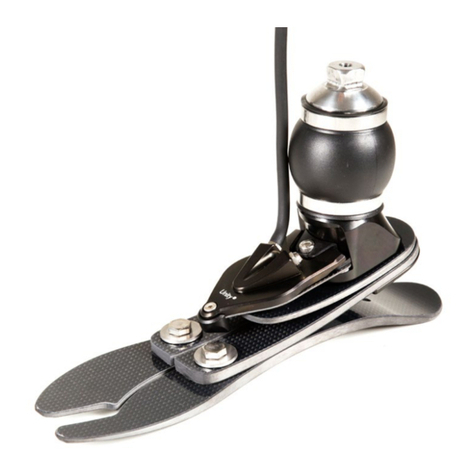
Ossur
Ossur PRO-FLEX LP TORSION W/UNITY Instructions for use
